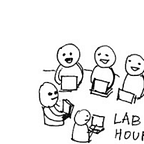by Mar Mcmahon
Recreating the Past: Muriel Cooper John Maeda
Tired but feeling freshly cohesive after our retreat at the Strange Foundation, we began the week by looking at the works of design pioneer Muriel Cooper and “humanist technologist” John Maeda. Crucial to reproducing some of these two artsts’ works, we learned how to incorporate fonts into openFrameworks projects. We also learned all about the differences between points, paths, polylines, and meshes.
Critical Theory: Intro to Blackness & Surveillance
This week, we started examining the intersection of blackness and surveillance. As a launching point for our discussion, we read Simone Browne, “Introduction, and Other Dark Matters” from Dark Matters: On the Surveillance of Blackness. Some of the questions that came up in our discussion: How can the surveillance of blackness help us understand the social conditions of surveillance more generally? How do new technologies change the invasiveness and effectiveness of surveillance? How does surveillance impose race on the body?
RaFia, the Brooklyn multimedia artist behind #PAYBLACKTiME, visited the class to talk about some of her work.
On Saturday, we all took a trip to see American’s show I’m Blue (If I Was █████ I Would Die) at Koenig & Clinton. American answered all sorts of questions we had about the piece—ranging from the specifics of fabricating the desks and blue blackboard, to responses to the show.
Hardware
This week we all enjoyed a much-needed break from hardware homework. During class, Taylor and Tiri introduced a new challenge for us to work through: how to transform NAND gates into other types of gates. NAND gates are special because they are “universal”, meaning that they (along with NOR gates) can be combined to form all other basic logical operations. In this class, we all translate NAND gates into inverters and OR gates.
We also learned the basics of capacitors, inductors and relays. Ariel and Luisa went on to build this stunning interactive sound/light dialogue mobile using oscillators and light sensors.
We got a quick introduction to the half adder and the full adder. It was exciting to gain a little concrete insight into the smallest logical components that make computing possible.
Scrapism
Sam introduced us to using cURL, which is necessary when you want a script to scrape without looking suspiciously “inhuman”. We learned how to convert cURL requests into Python for use in our Python scripts. As an example, Sam worked with images and text from the New York Times wedding announcement section 🤮🤮🤮.
We also took a look at spaCy, a natural language processing library that most of us found pretty intuitive when it comes to things like counting types of words, filtering grammatical classes, and so on. We also explored a less-intuitive component of NLP: “similarity scores” between words. Last, the more pedantic among us got in a little fight about whether noun adjuncts (nouns that “act like” adjectives, like the “cheese” in “cheese pizza”) are, or are not, actually adjectives. Spoiler alert: they’re still nouns!!
One interesting homework assignment completed for this week was Joseph Wilk’s audio list of 2,842 unique voices from diverse linguistic backgrounds.
Professional Development
Lauren led a workshop about the roles that the articulation and sharing of ideas can play in a creative practice. She also shared anecdotal insights into how productive the extensive documentation of a creative process can be toward goals like securing a healthy budget for a project. Last, we talked a little about using contracts as a way to advocate for artists to advocate for themselves.
